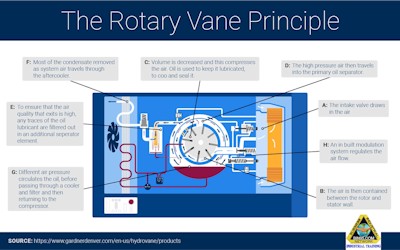Types of Air Compressors
- Home >
- articles >
- mechanical >
- types of compressor
Understanding Air Compressors Types
Throughout the industry, air compressors have always served as an invaluable tool. They seamlessly power pneumatic tools, spray guns, air conditioners, and heaters. These machines are also used for more unique applications such as roller coasters and creating snow banks for indoor ski centers. Below is an introduction to the types of air compressors and their use.
Types of Compressor:
Low Noise Air Compressors
When using any form of tools or machinery, your health and safety is of utmost importance. A common complaint of air compressors is the noise they generate and prolonged exposure can cause lasting damage to your hearing.
Consider a low noise air compressor to protect you and your staff. 60dB is considered safe and anything over 85dB has been known to cause issues with users. A low noise air compressor uses the addition of an acoustic chamber to safely reduce noise levels to 40dB.
Single Phase and Dual-Phase Air Compressors
These are the most common type of air compressor and both operate in very similar ways, dual-phase has one more step to the process.
A single-phase, also known as a piston compressor, draws air into the cylinder to then be compressed to roughly 120 PSI (pounds per square inch). The air is then sent to a separate storage tank awaiting use.
Dual-phase follows these steps, but before the air is stored, it is sent to a second cylinder for another round of compression, this time to 175 PSI.
Both of these machines can be powered by electric or petrol. Single-phase are typically smaller machines and found in DIY and smaller workshops. Dual-phase are more robust and suited for larger-scale applications.
Fixed vs. Variable Speed Compressors
The varying factor in these machines is how the motor gains its power, this affects the usability, lifespan, and efficiency of the air compressor.
A fixed speed air compressor sends a continuous stream of power to the motor. In return, this provides a reliable frequency. They are easier and cheaper to maintain but are less energy-efficient than their counterparts.
A variable-speed compressor (also known as VFD (Variable Frequency Drive) and VSD (Variable Speed Drive) can automatically adjust the power sent to the power in relation to the demand for air. Achieved with the use of diodes, a VSD converts the power twice, firstly to AC and then to DC. Subsequently, this then acts as switches to control frequency.
A VSD may be higher in initial cost but can save capital over time with the reduction of energy usage.
Oil and Oil-Free Air Compressors
All air compressors require lubrication within the cylinder to efficiently and safely draw in air. These can be achieved in two ways, oil, and oil-free.
Oil-free machines use a non-stick coating, usually Teflon, to gain lubrication. These machines require no further maintenance in relation to their lubrication. As they have fewer elements to the machine, they are more lightweight and often cheaper to purchase.
However, this non-stick coating will eventually wear away, causing diminished efficiency and you may be required to replace the machine.
Oil-based air compressors do require more maintenance to ensure adequate oil and come with the additional cost of purchasing oil. However, they are stronger and more durable than oil-free models and tend to have a longer lifespan.
Piston, Scroll and Rotary Screw Compressors
Throughout this article, all air compressors mentioned use pistons which is a generic system for a scroll compressor (also known as a reciprocating compressor). The alternative is a rotary screw compressor, which works in a slightly different manner.
A scroll compressor uses a piston to travel downwards to decrease pressure in the internal cylinder by creating a vacuum. Due to this sudden change in pressure, the door to the cylinder is forced open and the air is drawn in.
The piston then travels upwards, increasing pressure and forcing air out at a higher pressure point. This is then repeated in a reciprocating ‘scroll’ pattern. These machines have greater efficiency and can cool down quickly. However, they are more complex machines and therefore require more maintenance, they are also high in the initial cost.
A rotary screw compressor works in a similar fashion but replaces the piston with rollers. These rollers are placed just off the central shaft, with one side in constant contact with the wall. These rotate at extreme speed to cause the same results as a piston. They are easier to maintain and more affordable to purchase but do have limited cooling abilities.
Whether you are looking to invest in an air compressor or searching for an upgrade for a current machine, it is imperative to gain an understanding of these machines to ensure the right choice is made for you and your business. direct air has created the above infographic to provide an easy visual for this process.
learn more about air compressor types:
Below are our recommend educational material…
Air Compressor Training Certificate Course
Copyright © 2019 Business Industrial Network and Https://bin95.com. All rights reserved.
Although, we do encourage you to share a link to this article, as the more who read it, the more companies will save.

